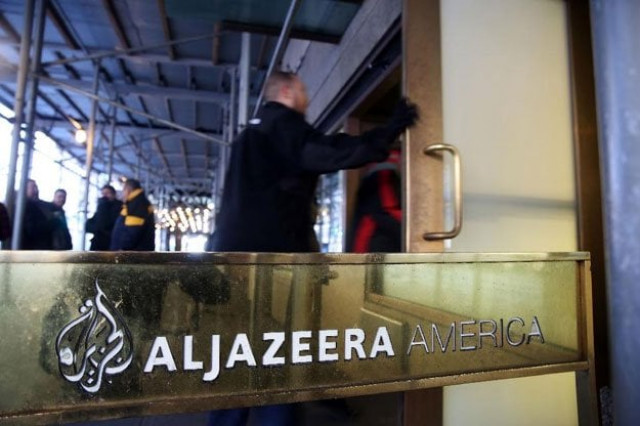How Al-Jazeera America was destined for failure
Today, the obvious question outside the US is: when AJAM was doing all the right things then why is it packing up

People walk into the offices of Al Jazeera America on January 13, 2016 in New York City PHOTO: AFP
Nicknamed AJAM, the channel’s news tasting fashioned itself along The Nation, America’s 150-year-old weekly magazine branding itself “a beacon of integrity and idealism, and a testament to the importance of a free and vital press.” The weekly continues to survive today but primarily on donations rather than subscriptions.
Al-Jazeera ending US cable news channel April 30
Prima facie, the channel’s launch in 2013 could not have been better timed when CNN faced an identity crisis with tumbling prime-time ratings and Fox News was increasingly seen as too conservative and white. With the slogan ‘There’s more to it’, AJAM bagged quite a few awards for documentaries and for raising the bar on domestic news coverage on stories such as the West Virginia chemical leak contaminating water supply, profiling of a marginalised LGBT community or coverage of the Black Lives Matter movement. The channel was known neither for partisan punditry nor US signature celebrity sensationalism. The channel’s short-lived intervention on the American media scene will be known for an extremely diverse newsroom against heavily male-dominated and white eclipsed rival new sources.
The downward spiral
Today, the obvious question outside the US is: when AJAM was doing all the right things then why is the channel packing up in less than three years? If one takes a closer look, the largest cable news rollout in a generation – Al Jazeera spent $500 million to buy Al-Gore’s struggling Current TV – is taking its final breaths for some gross marketing miscalculations and a variety of other factors.
Al-Jazeera pulls plug on struggling US news channel
The first and the foremost is the channel’s viewer base. No matter how exclusive, diverse and in-depth it’s reporting and programming has been, a TV news source does not become influential without a significantly large viewer base. Though it reached a deal with Time Warner Cable, opening up the possibility of distribution in 55 million households, the Dish Network or DirectTV did not offer AJAM on a regular cable package. The channel was exclusive for those who could pay extra for premium content.
The distribution challenge originated partly from the brand and its image. For an average American, the logo looked like stylised Quranic text. The name Al Jazeera was either alien to the common man or was known for Osama bin Laden videos and anti-US coverage. Documents leaked to the UK press indicated that US president Bush considered air strikes on Al Jazeera’s Doha offices in 2004. The coalition bombed its Arabic channel’s bureaus in Afghanistan and Iraq. The management’s insensitivity or over-confidence about the brand’s legacy is also largely to be blamed here.
Turkish state broadcaster kicks off recruitment drive in Pakistan
The channel’s executives premised that the US cable news are far too provincial, and leave out too many voices from across the national spectrum. The other ambition was to reconnect the American viewer with the ‘real’ world. Ironically, the closure of AJAM is happening at a time when Republican frontrunner Donald Trump has done a tremendous job at reviving a dying white supremacist movement in the country.
The infighting within the management brought it plenty of negative media coverage. In an ideal scenario, a news source must never become news itself. But thanks to the arrogance of those at the top of the hierarchy in the US, Al Jazeera tried to implement a model tested outside the US domestic market. An experimental approach could have served better, a lot better.
While its ad-supported rivals relied on less expensive ways to deliver news, AJAM banked too heavily on investigative work, paying handsome cash to journalists abroad while neither having a significant viewer base nor advertisement revenue to sustain it.
A lesson for others
The AJAM experience goes to show that infotainment – which has become the trademark of media industry, be it the US or elsewhere in the Middle East and Pakistan – makes a media house viable but at the cost of serious, investigative journalism. With the invasion of social media, journalism itself has become a niche. Its fate reinforces the depressing conclusion that appetite for in-depth, quality news is extremely vulnerable to structural challenges and financial woes.
Al-Jazeera cameraman killed in Syria
The experiment also reminds journalists and viewers that specialised or investigative journalism can’t be delivered like fast food. It must come at a premium price and with intense brand recognition. Al-Jazeera America failed to figure out both.
Even though cable news leaves much to be desired, the channel did not have a fighting chance in the US. The network’s fate was sealed from the get-go. Once hyper-ambitiousness, Al-Jazeera America is winding up with the same haste with which it roared into the United States.
Naveed Ahmad is a Pakistani investigative journalist and academic with extensive reporting experience in the Middle East. He is based in Doha and Istanbul. He tweets @naveed360



















COMMENTS
Comments are moderated and generally will be posted if they are on-topic and not abusive.
For more information, please see our Comments FAQ